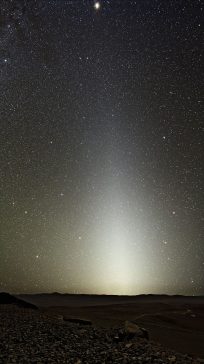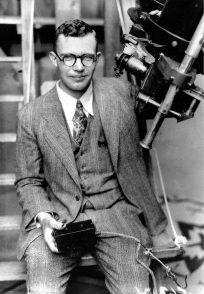
 • Feb 2 – For the next two weeks, look for the Zodiacal Light in the western evening sky. In late winter and early spring, it is seen for a couple of weeks in the western sky just after sunset, but in late summer, early fall, it is seen in the dawn sky and is sometimes called the “false dawn”. From a dark sky location, away from city lights, it will appear as a strange glowing light in the shape of a cone, or pyramid. The light is the result of the Sun’s light, reflecting off the dust grains that float around in between the planets. These dust grains are the leftover material that went into the making of our solar system. Look along the western horizon about an hour after sunset. Avoid evenings when the moon is bright.
• Feb 2 – For the next two weeks, look for the Zodiacal Light in the western evening sky. In late winter and early spring, it is seen for a couple of weeks in the western sky just after sunset, but in late summer, early fall, it is seen in the dawn sky and is sometimes called the “false dawn”. From a dark sky location, away from city lights, it will appear as a strange glowing light in the shape of a cone, or pyramid. The light is the result of the Sun’s light, reflecting off the dust grains that float around in between the planets. These dust grains are the leftover material that went into the making of our solar system. Look along the western horizon about an hour after sunset. Avoid evenings when the moon is bright.
• Feb 7 -Last Quarter Moon officially occurs at 9:54 A.M. CST.

• Feb 8 – During the hours before sunrise, look to the south to see a waning crescent moon in between the planets Mars and Jupiter.

Jules Verne
On this day in 1828, author Jules Verne was born in Nantes, France. Verne’s impact on the development of science fiction and his influence upon science and technology cannot be overstated. With works such as Around The World In 80 Days, 20,000 Leagues Under The Sea, and From The Earth To The Moon Verne would inspire future generations of writers and scientists. Apollo 8 astronaut Frank Borman once said, “In a very real sense, Jules Verne is one of the pioneers of the space age.”
• Feb 11 – The moon is at apogee, it’s most distant point in its orbit for the month, at 8:16 A.M. CST, at a distance of 252,090 miles from Earth.
• Feb 15 – New Moon occurs at 3:05 P.M. CST (South America and Antarctica will see a partial solar eclipse at this time, it will NOT be visible in North America)
 • Feb 17 – On this day in 1930, at 4:08 A.M., the town of Paragould, AR received a visitor from outer space. During the early morning hours, residents were awakened to the sound of three distinct sonic booms, the result of a large meteor exploding in Earth’s atmosphere. The object broke into many pieces and the largest recovered was found on a farm south of Bethel Church off of Highway 358. It was a stony meteorite weighing in at 820 pounds, the second largest stony meteorite ever recovered. It is now on display at UA Fayetteville.
• Feb 17 – On this day in 1930, at 4:08 A.M., the town of Paragould, AR received a visitor from outer space. During the early morning hours, residents were awakened to the sound of three distinct sonic booms, the result of a large meteor exploding in Earth’s atmosphere. The object broke into many pieces and the largest recovered was found on a farm south of Bethel Church off of Highway 358. It was a stony meteorite weighing in at 820 pounds, the second largest stony meteorite ever recovered. It is now on display at UA Fayetteville.

Clyde Tombaugh
• Feb 18 – On this day in 1930, Clyde Tombaugh discovered the dwarf planet Pluto
from the Lowell Observatory in Flagstaff, AZ.
• Feb 23 –First Quarter Moon will officially occur at 2:09 A.M. CST
• Feb 27 – The moon is at perigee, its closest point in its orbit to the Earth for the month, at 8:39 A.M. CST, at a distance of 226,137 miles.

• Jan 8 – Last quarter moon occurs at 4:25 P.M. CST

Stephen Hawking
Theoretical physicist and cosmologist, Stephen Hawking was born this day in 1942.
• Jan 14 – The moon is at apogee, its most distant point in its orbit for the month at 252,565 miles distant at 8:10 P.M. CST.
• Jan 16 – New Moon occurs at 8:17 P.M. CST.
• Jan 24 – First quarter moon occurs at 4:20 P.M. CST.
• Jan 30 – The moon is at perigee, its closest point in its orbit around the Earth at a distance of 223,068 miles, at 3:57 A.M. CST.
 • Jan 31st – Full Moon occurs 7:27 A.M. CST; total lunar eclipse. The moon will be very low upon the WNW horizon so you will need a clear view from your viewing location. Total eclipse begins at 6:51 A.M. CST with maximum eclipse occurring at 6:56 A.M. CST. By 7:08 A.M. CST the moon will have set below the horizon. This eclipse certainly does not favor those of us in the CST zone but it might be worth checking out if you are up and about at this hour.
• Jan 31st – Full Moon occurs 7:27 A.M. CST; total lunar eclipse. The moon will be very low upon the WNW horizon so you will need a clear view from your viewing location. Total eclipse begins at 6:51 A.M. CST with maximum eclipse occurring at 6:56 A.M. CST. By 7:08 A.M. CST the moon will have set below the horizon. This eclipse certainly does not favor those of us in the CST zone but it might be worth checking out if you are up and about at this hour.
Being the second full moon in a month qualifies it as a “blue moon”. Being so close to perigee means that it also qualifies as a “supermoon”. And, as this is an eclipse, some will call it a “blood moon”. So, it seems that we will have a super blue blood moon on this morning. Having all three of these conditions occurring at the same time is something that hasn’t happened for over 150 years. To see it at its best, you will need to be on the Pacific Coast.